Serviços Personalizados
Journal
Artigo
Indicadores
Links relacionados
Compartilhar
Portugaliae Electrochimica Acta
versão impressa ISSN 0872-1904
Port. Electrochim. Acta vol.30 no.5 Coimbra set. 2012
https://doi.org/10.4152/pea.201205329
Determination of Half-wave Potentials of Selected Chlorophenols
M.O. Iwunze* and B. Abel
Department of Chemistry, Morgan State University, Baltimore, MD 21251, USA
Abstract
Cyclic voltammetry was used in cetyltrimethylammonium bromide (CTAB) micellar solution to determine the half-wave potentials of selected chlorophenols, CPs. It is observed that all the electrochemical parameters of the studied CPs decrease with an increase in the number of chlorine atom(s) attached to the parent compound. The mathematical relationship between the obtained E1/2 and the number of chlorine atoms in the parent compound is given. The formal potentials, E0', of the CPs are approximated from the obtained half-wave potentials.
Keywords: cyclic voltammetry, half-wave, potential, formal, chlorophenols, electrochemical, parameters.
Introduction
Chlorophenols (CPs) are halogenated phenols. They are used not only as herbicides and bactericides but also in wood preservatives and pharmaceuticals. As a result of their numerous uses, they are eventually released to the environment. They are known to be toxic and listed as toxic chemicals [1]. The EPA has subsequently listed them as carcinogenic [2, 3]. These toxic/carcinogenic chemicals require analytical technique in detecting and detoxifying them. One of the major analytical methods used for detecting and characterizing the CPs is electrochemistry [4-12]. The parameter that is often used is the half-wave potential (E1/2) [4-6]. This parameter has been used in quantitative structure-property relationship (QSPR) [13-15] and in correlation with the physical and chemical properties of other compounds [16-19]. E1/2 has also been predicted using the quantitative structure-electrochemistry relationship (QSER) [20, 21]. However, to the authors' knowledge, the E1/2 has not been used in characterizing the CPs. It is the theme therefore of this work to determine the influence of chloride ion attached to the parent compound, phenol, on the E1/2 of selected CPs for their characterization. Most CPs are not soluble in water, the experiment in this work is therefore conducted in a micellar solution of 1.0 mM cetyltrimethylammonium bromide (CTAB).
Experimental
Chemical
All the CPs used in this work were all purchased from Aldrich Chemical Co. They are 99.0 % pure or are the purest grade from the manufacturer. A 99.0 % pure CTAB was obtained from Acros Organics. ACS reagent grade potassium chloride (KCl) was obtained from Fisher Scientific Co.
Apparatus
All electrochemical experiments were conducted using a three-electrode system comprising of the working electrode (1.0 mm diameter) Glassy Carbon Electrode (GCE) obtained from Cypress Systems, a wound platinum wire as the counter electrode and a commercial calomel electrode as the reference electrode which was obtained from Fisher Scientific in a 1-compactment electrochemical cell. A computer-controlled electrochemical analyzer system supplied by Cypress Systems, Model CS-10190 was used to obtain the requisite voltammograms of the CPs. The polisher, Metaserv®200, a brown polishing cloth, to resurface the electrode surface and 0.05 micron α-aluminum powder, used in conjunction with the polishing cloth were obtained from Buehler Ltd.
Methodology
Different amounts of the congeners of cps were weighed into four respective 10.0 mL volumetric flasks containing 0.0110g KCl. The content of the flasks were dissolved and diluted to mark with 1.0 × 10-3 M CTAB. The concentration of each congener was 1.0 × 10-3 M and the concentration of the KCl was 0.15 M. These flasks were then gently sonicated to make the resulting solutions homogeneous before transferring them to the electrochemical cell where they are scanned from 0.0 to 1.2 V. After each scan the electrode surface was renewed by polishing. The CTAB solution was prepared with triply distilled water obtained from Reagent Grade Water System obtained from Photronix. All the reagents were used as received and the measurements were performed at room temperature, 25 ± 0.2 °C.
Results and discussion
Fig. 1 shows the chemical structure of the CPs studied in this work and the parent compound.
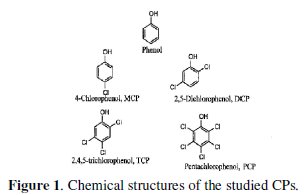
Fig. 2 is the forward segment of the cyclic voltammogram of the CPs.
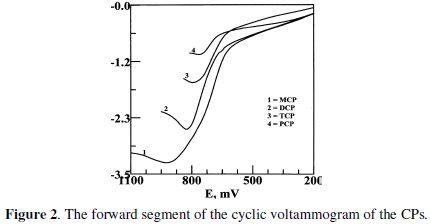
As can be seen in this figure, the peak potential and the peak current of the studied CPs are decreasing with an increase in the number of chlorine atoms in each congener. This observation is in accord with what is observed by other workers [22, 23].
We show in Fig. 3 the usual electrochemical plot of applied potential, E versus log(i/id-i) for the respective congeners which were used in determining the requisite E1/2 following the conventional electrochemical technique as given in equation 1.
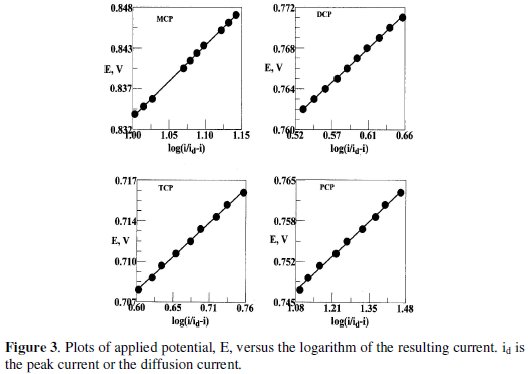

In this equation R and T are the universal gas constant and temperature in Kelvin scale, respectively. α, n and F are the electron transfer coefficient, the number of electron(s) involved in the reaction and Faraday's constant, respectively. i is the observed current and id is the diffusion or peak current. The plots gave intercepts which were taken as E1/2.
Table 1 lists the observed peak potential, peak current and the E1/2 of the respective congener of the CPs.

The observed parameters decrease as the number of chlorine atoms in the phenol is increased. A plot of E1/2 versus the number of chlorine atoms is shown in Fig. 4.
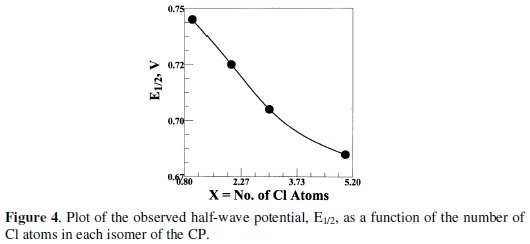
However, this plot is polynomial. We tried several mathematical equations that would be suitable to make the plot linear, in other make the data easy to interpret and its application easier and simpler. We found a good linearity between the E1/2 of the respective congener with the square root of the chlorine atoms attached to phenol. Therefore, a plot of E1/2 as a function of the square root of the number of chlorine atoms was made (Fig. 5).
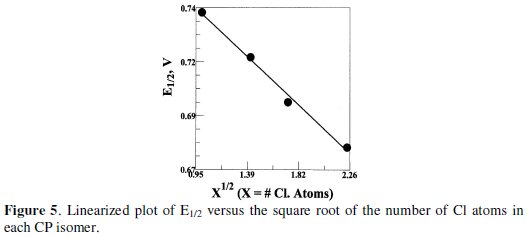
As can be seen, the plot is quite linear with the coefficient of determination, r2, of 0.9926 and a regression coefficient, r, of 99.63 %. From this plot a useful mathematical relationship that describes the obtained E1/2 of the CPs is:

The X in equation 2 is the number of chlorine atoms. The validity of this relationship can be substantiated by inserting zero for X. When this is done, the E1/2 that is obtained in the CTAB solution is 0.79, which is the E1/2 for phenol. This value, within an experimental error (uncertainty ± 0.054), is in agreement with what is observed by Yuan and his co-workers (0.799) [14] using the Multiple Linear Regression (MLR) program.
The obtained E1/2 values of the CPs could be used to approximate their formal potential, E0', in accordance with equation 3 [24]

In this equation the ratio of the diffusion coefficient of the oxidized specie, DO, and the reduced species, DR, is usually unity and E1/2 is then approximated to E0' [24]. The E0' thus calculated is also listed in Table 1.
Conclusion
CPs, which are known to be toxic and potentially carcinogenic are insoluble in water, but are relatively soluble in surfactant medium. The surfactant used in this work is cetyltrimethylammonium bromide, CTAB. We have shown in this work that the half-wave potential, E1/2, of CPs obtained by cyclic voltammetry in this medium decreases with an increase in the number of chlorine atom(s) attached to the parent compound. A linear mathematical relationship between the observed E1/2 of the chlorine content of each isomer of the studied CPs is given and the formal potential, E0', of the CPs is consequently approximated in accordance with the literature.
References
1. www.atsdr.cdc.gov/az/c.html [ Links ]
2. US Environmental Protection Agency April 1979 National Recommended Water Quality Criteria - EPA 822-Z-99-001 [ Links ]
3. Keith LH, Telliard WA. Env Sci Tech. 1979;13:416. [ Links ]
4. Lund H. Acta Chem Scand. 1957;11:1323. [ Links ]
5. Yang H, Hou H, Fan Y. Inorg Chimica Acta. 2009;362:2418 [ Links ]
6. Elving PJ. IUPAC. 1963;7:423. [ Links ]
7. Zutshi K. Introduction to Polarography and Allied Techniques. India: New Age International; 2006. [ Links ]
8. Terashima C, Rao TN, Saarada BV, Tryk DA, Fujishima A. Anal Chem 2002;74:895.
9. Peeters K, De Wael K, Bogaert D, Adriens A. Sens Actuat B 2008;128:494. [ Links ]
10. Sorrells CA, Shaikh AU, Samokyszyn VM. J Arkansas Acad Sci. 2002;56:169. [ Links ]
11. Rodgers JD, Jedral W, Bunce NJ. Env Sci Technol. 1999;33:1453. [ Links ]
12. Liu H, Wen Y, Luan F, Gao Y, Li X. Eur J Chem. 2009;7031:439.
13. Yuan S, Xiao M, Zheng G, Tian M, Lu X. SAR QSAR Environ.. Res. 2006;17:473.
14. Engineering Science Paper Quantitative Structure Property Relationship and Its Application in Capillary Electrophoresis. www.engpapers.com/66924.html; 2012. [ Links ]
15. Chen YM, Guo LH. J Env Sci. 2009;21:373. [ Links ]
16. Loutfy RO, Loutfy RO. Can J Chem. 1976;54:1454. [ Links ]
17. Ruoff RS, Kadish KM, Boulas P, Chen ECM. J Phys Chem. 1995;99:8843. [ Links ]
18. Loutfy RO, Loutfy RO. J Phys Chem. 1972;76:1650. [ Links ]
19. Mohammadhosseini M, Nekoei M. 6th Annual Seminar of Electrochemistry of Iran Kish International Convention Center; 2009 Oct 9-11: Iran. [ Links ]
20. Nekoei M, Kohammadhosseini M, Gharahbagh AA. Anal Bioanal Electrochem. 2009;1:159. [ Links ]
21. Peng Y, He S, Wang J, Gong W. Radiation Phys Chem. 2012;81:1629. [ Links ]
22. Schmid S, Krajnik P, Quint RM, Solar S. Radiat. Phys. Chem. 1997;50:493. [ Links ]
23. Ezerskis Z, Jusys Z. Pure Appl Chem. 2001;73:1929. [ Links ]
24. Bard AJ, Faulkner LR. Electrochemical Methods: Fundamentals and Applications. 2nd ed. New York: John Wiley & Son; 2001. [ Links ]
Acknowledgements
The authors are grateful to the chemistry department of Morgan State University for support for this work.
*Corresponding author. E-mail address: maurice.iwunze@morgan.edu
Received 22 October 2012; accepted 31 October 2012














